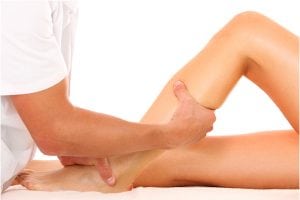 The purpose of physical therapy is to provide some type of pain relief either in a passive way (by soothing sore muscles) or in an active way (by strengthening core muscle groups). If you’re living with back pain or recovering from spine surgery, you’ll likely benefit from physical therapy.
The purpose of physical therapy is to provide some type of pain relief either in a passive way (by soothing sore muscles) or in an active way (by strengthening core muscle groups). If you’re living with back pain or recovering from spine surgery, you’ll likely benefit from physical therapy.
Since sessions can be highly individualized, it’s considered one of the most effective ways to manage pain and recondition muscles and tissues that support bones and joints.
Passive Physical Therapy
Physical therapy that’s primarily therapeutic is known as passive physical therapy (modalities). It involves techniques such as the delivery of mild electrical currents through water to the skin (iontophoresis) and massage therapy that are done to bring pain levels down to manageable levels. Passive PT can provide short-term relief from chronic pain and help manage occasional flare-ups that sometimes happens with conditions such as non-specific low back pain.
 Some other examples include:
Some other examples include:
- Application of heat and ice, usually for 10-20 minutes at a time
- TENS (transcutaneous electrical nerve stimulation) units
- Ultrasound
- Hydrotherapy
Active Physical Therapy
Requiring active participation from patients, this type of physical therapy focuses on strengthening core muscle groups, including abdominals, pelvic floor, and deeper muscles supporting the spine, and improving flexibility and range-of-motion. For back pain management and muscle conditioning, this may involve strengthening hamstring (thigh) muscles a few times a day and low-impact aerobic exercises such as swimming and walking.
Active PT exercises are often under the supervision of a licensed physical therapist, although patients may be given recommendations for exercises they can safely perform on their own.
Active PT typically includes:
- Dynamic stabilization exercises with exercise or balance balls
- Hyper-extensions targeting lower back muscles
- Yoga and Pilates
- Cardiovascular exercises
Benefits of Physical Therapy
Physical therapy is often a cost-effective way for patients to enjoy welcome relief from pain. The various techniques and methods involved with PT can eliminate the need for immediate surgery, which is typically elective when back pain is involved, or negate the need for surgery at all. PT may be therapeutic for patients with conditions such as sciatic nerve pain or narrowing of the spinal canal (scoliosis).
PT promotes healing and the strengthening of muscles following surgery. For some patients, passive physical therapy also has relaxation benefits. The same is true with some low-impact forms of active PT such as yoga and water aerobics. It’s also worth considering for patients who wish to lessen their dependence on pain medications, many of which are only meant to be used on a short-term basis.
The key to enjoying meaningful results from physical therapy is having an accurate diagnosis for your pain, especially if it’s reached a point where it’s fairly persistent.
Our therapists will use diagnostic results and input from your doctor to fine-tune sessions and recommend exercises and techniques likely to be effective. Get more out of sessions by consistently communicating with your therapist to let them know where adjustments need to be made and what’s working for you.




